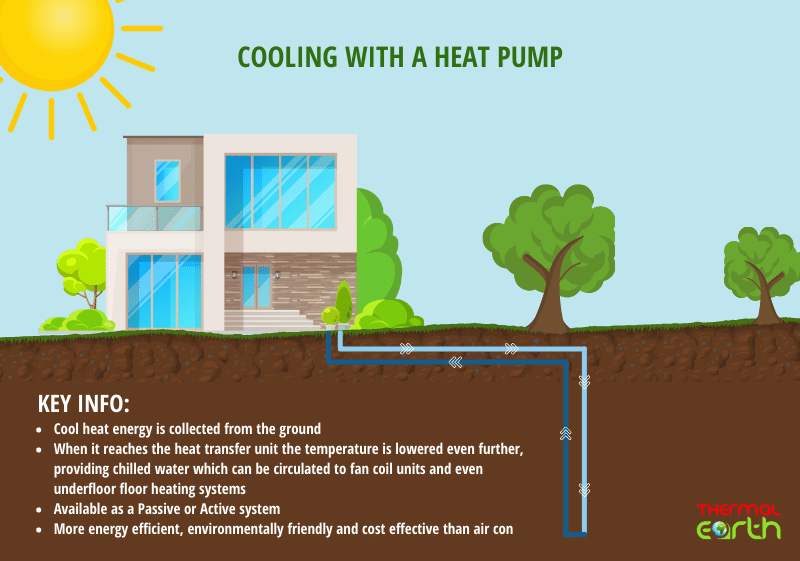Cooling from Ground Source Heat Pumps

As well as providing year- round ambient heating and hot water, heat pumps can also work in reverse to provide passive and active cooling.
What is Passive Cooling?
Passive cooling works by circulating the water and refrigerant mixture (brine) through the pipework buried in the ground (known as ground collectors or ground arrays), the brine is cooled by the lower temperature of the ground before being circulated to a heat exchanger which further reduces the temperature, providing chilled water. The water is then distributed to cooling fan coil units or underfloor heating. If you're planning to use fan coil units you’d need one in each room which requires climate control.
Pros of Passive Cooling:
- Can be installed as part of your heat pump system saving time, money and space.
- Low cost to run – only uses energy to circulate the brine through the system.
- 100% carbon free if used with renewable electricity suppliers such as Octopus Energy.
- Moves the warm energy from the building and charges the ground with it throughout the summer ready to be extracted in winter months, increasing efficiency.
- Increased comfort levels.
Cons of Passive Cooling:
- If using passive cooling with underfloor heating, care should be taken as condensation can build up in the form of dew. We recommend using a dewpoint measurement which will reduce the temperature of the cooling water to prevent condensation of atmospheric moisture.
- Passive cooling is not as effective as an Active Cooling system as it doesn't operate at the same low water temperatures.
What is Active Cooling?
Active cooling requires the circuits to the evaporator and condenser to be swapped. This allows heat energy to be taken from the circuit which usually provides heating and transfer it into boreholes or water via the ground collectors. This method of cooling is more effective than passive and shares greater performance levels with air-con.
Pros of Active Cooling:
- More effective than passive cooling as a set cooling temperature can be maintained
- Higher performance in line with traditional air conditioning
- Can be installed as part of your heat pump system saving time, money and space
- 100% carbon free if used with renewable electricity suppliers such as Octopus Energy
- Moves the warm energy from the building and charges the ground with it throughout the summer ready to be extracted in winter months, increasing efficiency.
- If the brine gets too warm, the system will become inefficient. This can be caused when the building gets so hot that the temperature of the brine increases slightly with each circulation and so the compressor is unable to lower the temperature so that it’s suitably chilled.
Cons of Active Cooling:
- Requires slightly more energy to operate than passive cooling making which increases running costs (still considerably less than air-con)
- Can be limited by the minimum allowable temperature of the cooling circuit or the ability of the borehole or water source to disperse the heat.
Which is Best – Passive or Active Cooling?
This depends on you and your preferences. If you’re looking for the most energy efficient system and the temperature of your property does not reach excessive heat levels then we’d suggest passive cooling. However if your property does reach uncomfortably hot temperatures during the summer season we’d recommend Active cooling as a more effective system.
Do the ground collectors impact the cooling ability?
The type of ground collectors used for the installation do have an impact. Boreholes and water source are most effective as both normally interface with ground water which allows high heat transfer rates.
Why Choose a Heat Pump Over Air Con?
- Reduced running costs - The system uses less energy and so helps to reduce your monthly utility bill
- Can be installed as part of one system, rather than separate heating and cooling systems to save space
- More sustainable and environmentally friendly – If you use an energy provider which generates renewable electricity your system will be 100% carbon-free
- Low Maintenance - Heat pumps require less maintenance and have an increased lifespan of around 20 years
- Cost – As you’re combining a heating and cooling system in one, you may find that the cost is lower than installing separate heating and cooling systems
- Government Incentives - From 1st April 2022, you can obtain the Boiler Upgrade Scheme to help cover the cost of installing a heat pump.
If you have any questions about passive or active heating with a heat pump, submit an enquiry today or call us on 01269 833 100. We provide free, no obligation advice.
 Facebook
Facebook LinkedIn
LinkedIn Twitter
Twitter













